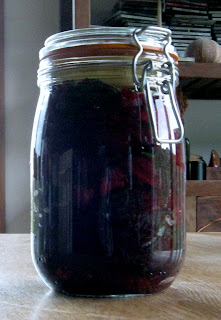An art indeed in the post-modern, post-global, peak oil, food-insecure… era is the storing of foodstuffs in order to be able to provide in times of scarcity. Jo Newton of Irish Seed Savers teaching on Patrick Whitefield’s excellent Sustainable Land Use Course looked yesterday at the myriad methods of doing this, an enabling and empowering step towards self-sufficiency. I offer a list here, and hope to cover most of the means of food storage in this blog over the seasons.
In the GROUND
Recent harsh winters are making it harder to store in the ground, but many roots, such as Oca, Swede, Jerusalem Artichokes, Salsify and Parsnips will happily sit snug in the ground over winter – the only difficulty is in digging them.
SILOS and CLAMPS
Both are traditional methods of food storage. A SILO is a hole in the ground, aerated with straw, leaves and branches into which the roots are placed and then covered in earth. While more suited to wet climates, a CLAMP is a pile of veg on the ground, similarly mixed with a material – nettle straw a traditional one for keeping off vermin, around which a trench is dug, the earth is used to cover the pile. The terms are continue to be used in modern industrial agriculture, but the meanings are somewhat altered.
STORING ROOTS and FRUITS
Otherwise, buckets or boxes in which particularly carrots, beetroots and celeriac are layered and covered with sand, peat, leaf mould, straw or sawdust, a slightly moist mulch to keep the veggies fresh, at a constant 4C or thereabouts to prevent roots shooting or freezing.
Apples and pears can be stored on palettes with air circling between them. They keep better than roots due to their high level of acidity.
Pumpkins and Squashes keep very well, and in warmer temperatures (up to 10C) provided they have been ripened off and their shells are hard. Ripen off by leaving in direct sunlight, or using a cloche if necessary.
Don’t keep anything showing signs of mould or rot as this will spread fast.
DRYING and DEHYDRATION
Windowsills, Dashboards and Airing Cupboards can be used for drying pulses, fruits, tomatoes… hang your apple rings in the kitchen window. Herbs are best dried away from direct sunlight in order to preserve their volatile oils. In the case of wetter fruits and veggies a solar-dehydrator might be in order…
SMOKING and CURING
Used for meats and fishes and often involving salt these are pre-freezer methods of storing… Gravadlax is one of my favourite and all-too-easy to do at home. Recipe to be posted, one day.
PASTEURISATION and STERILISATION
While Pasteurisation (see previous blog) happens at 72C for 20 minutes, Sterilisation happens over a longer period of time at 100C.
FREEZING
While freezing is an exceptional means of conserving fresh vegetables without them losing any nutrients it demands much gas and electricity… commodities not to be reckoned on.
LACTO-FERMENTATION
A no-energy means of preserving, a skill lost and returning to Europe with a new-found sense, see my many previous blogs on the subject.
In SUGAR, In SALT, In BRINE, In VINEGAR, In ALCOHOL…
A myriad ideas and recipes to follow over the coming year.


















